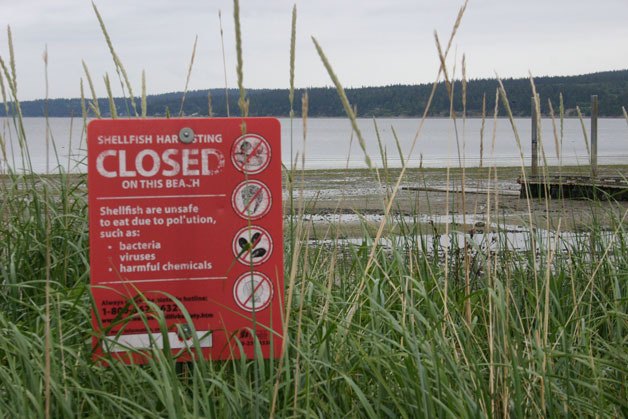The tainted waters at the south end of Holmes Harbor have improved dramatically, leading to the possibility they will be declared safe for swimming, wading and shellfish harvesting later this year.
Warning signs posted at Freeland County Park have long declared “the current conditions at this beach are not suitable for recreational water activities. Small children and people chronically ill people are at higher risk for increased illness.”
One sign flatly states “no swimming” and “no wading,” and another bans clamming entirely. Monday was one of the lowest tides of the year, at minus 3.4 feet, and the acres of clam grounds were devoid of clam diggers, no doubt making for happy clams.
It was high fecal coliform test results that forced the beach closure. In 2006, a shellfish protection district was created by the state Department of Health, working with the Island County Health Department and area residents. A concerted effort began to clean up the waters flowing into the south end of Holmes Harbor.
With help from the Whidbey Island Conservation District, the cleanup took years. They made sure small hobby farms weren’t contributing to the problem. The county publicized the need for dog walkers to pick up after their pets, making waste bags available at the park. And homeowners around Holmes Harbor were particularly encouraged to comply with the county’s new septic ordinance, requiring inspections every three years for most septic tank owners, but every year for those living near the water. Inspection rates are far higher than the county average.
“The water quality in the drainage has significantly improved,” said Jule Schultz, restoration lead for the project with the state. “They did a great job.”
“The concerns we have now are summer time use,” he added. “We have to make sure the marine waters are clean. You guys have a lot of stuff that washes up on that beach.” There was a red tide Monday, but usually those are not considered dangerous.
The county will continue testing the waters this summer with hopes of opening the area to banned recreational uses as early as this fall. “We are very optimistic there will be an upgrade later this year to some form of opening,” said Jill Wood, Island County’s environmental health director, last week.
Wood noted that the state ordered the closure and will decide when to open the waters to swimming and wading.
“We’ve been actively working in the watershed since 2007,” Wood added, also mentioning the septic, farming and pet dropping programs. Homeowners are also urged to use proper lawn care and car care to avoid pollution runoff problems.
“We’ve taken a proactive role in the watershed,” she said.
A newsletter from Island County Public Health will soon be sent to residents of the shellfish protection district informing them of the good news of the latest test results. From 2010 to 2012, fecal coliform has dropped 70 percent at the Freeland Park storm water outfall, 64 percent at the Freeland Creek beach outfall, 60 percent at the Woodard Avenue beach outfall, and 82 percent at the storm water outfall on Shoreview Drive. The only increase was a 15 percent jump at the wetland outfall at Shoreview Drive.
Schultz said the state Department of Fish and Wildlife controls clam digging. “They manage that resource,” he said. “But I think it will be opened for at least part of the year.”
Schultz, in the newsletter, tells residents that “the significant pollution control work that has been completed in the uplands by the local shellfish protection district and the county warrants an evaluation of the shellfish growing area.”
Once the current summer water testing is complete, Schultz stated, “We are optimistic the area will be upgraded.”
By fall, perhaps, the Holmes Harbor clams won’t be quite so happy.



